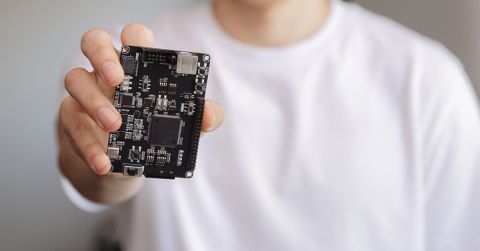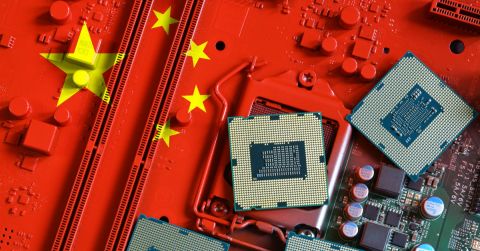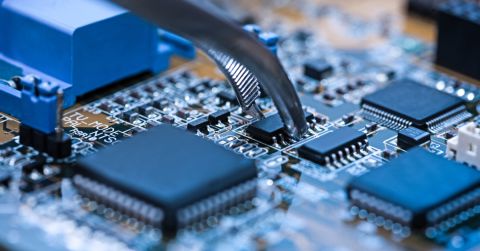Voltage-to-Frequency Converters Work Great With Knobs

So you’ve got a backlight you want to vary manually with a knob. Once you turn the knob, the information is ready as changing voltages for automatic processing. But, how do you process changing voltages to smoothly control a backlight. Or, you have a temperature sensor that you need to read and feed, to a microprocessor for uniformly heating a room. The sensor presents changing temperatures as a range of voltages. Now what do you do with them, should you want to feed them into a microprocessor for further processing.
Let’s back up. If you could send analog information to a microprocessor, how would you do it? Why would you do it? What would you want to tell the microprocessor? A microprocessor is a digital controller and requires information delivered in binary. Binary data is formed when one or more bits are collected and delivered in either serial or parallel bit streams.
Changing analog information is susceptible to degradation from electrical noise so being able to transmit sensitive information becomes problematic. In addition, you need to convert the analog information into digital information for processing by your system’s central processing unit. Enter the voltage-to-frequency converter.
Defining Characteristics of Voltage-to-Frequency Converters
Voltage-to-frequency converters came about as an accurate way to transmit sensitive analog information along lengthy transmission paths for processing by a CPU. The converters take an input voltage and output a pulse train with frequency directly proportional to input. Typically, the converters expect a changing range of analog voltage on the input which is proportionally mapped to a changing range of frequency at the output.
 Knobs communicate with embedded systems with VFCs
Knobs communicate with embedded systems with VFCs
Each unique input voltage is represented as a unique output frequency that is sampled and sent to a microprocessor, or another type of register, for processing. Once processed, the information continues downstream driving circuit blocks that cause panels to light up, or thermostats to change. Take the control panel discussed above. A human turns the knob. As the knob turns voltage changes; each defined step in the voltage outputs as a unique frequency. This produces a chain of frequencies, or binary words, that represent the range of change. This range of change, represented as unique frequencies, are sent to the microprocessor. The microprocessor takes the information and returns a drive command, directly to the backlight, causing its illumination to change.
This type of IC is suitable for analog-to-digital conversions. The type of analog-to-digital conversion is more modest when compared with some of the high-performance A2Ds used throughout embedded systems today. Conversion times are a bit slow, usually in the millisecond range. The more resolution required, the slower the conversion. But there are many applications where slow is steady and you’ll find these devices strutting their stuff when used with temperature sensors or for strain-gauge measurements. They are reliable over wide temperature range and the circuit is compact. Given that they output a frequency, sensitive analog signals at the input can be kept close together in the physical arrangement of parts. The output frequency is less susceptible to noise during transmission allowing it to travel to other circuit blocks without degradation.
Parameters to Consider When Selecting a Voltage-to-Frequency Converter
There are a few rules of thumb when designing with a voltage-to-frequency converter. For instance, you need to establish what your input voltage range will be. Additionally, you need to establish what your output frequency range will be. The entire range for each, input and output, are typically called full scale. As an example: If a 5V full-scale input outputs a 1MHz signal from the VFC, the full-scale period is 1/f = 1µs. If the microprocessor count period is 10ms, then the total full-scale count is 10ms/1µs = 10,000 counts. Using the total counts allows you to scale the input. For a 5V full scale input, 5V = 10,000 counts; 2.5V = 5,000 counts.
The VFC output frequency is received by the next circuit block which counts all the rising edges within a defined sampling period. In the above example, the sampling period was 10ms. This can be done with a microprocessor or for more simple applications with a binary counter into a latch. Using a counter converts the serial bit stream encoded within the VFC output to port into parallel output words or other encoded binary format. For the parts we highlight below, each vendor datasheet has application circuits showing how to use the VFC to build your design. One such circuit is shown below.
 Found on page 16 of Texas Instruments LMx31x Precision Voltage-to-Frequency Converters datasheet
Found on page 16 of Texas Instruments LMx31x Precision Voltage-to-Frequency Converters datasheet
The following selection of parts offers several versions of voltage-to-frequency converters with full-scale output frequencies, for sampling, ranging from 10kHz to 2.75MHz.
AD7741/AD7742, Single and Multichannel, Synchronous Voltage-to-Frequency Converters
These parts offered by Analog Devices provide full-scale output frequencies of either 1.35MHz or 2.75MHz. An evaluation board is available for development, the EVAL-AD7741.
The AD7741/AD7742 are a new generation of synchronous voltage-to-frequency converters. The AD7741 is a single-channel version in an 8-lead package and the AD7742 is a multichannel version in a 16-lead package. No user trimming is required to achieve the specified performance.
AD7741 Functional Block Diagram Found on page 1 of AD7741/AD7742 Single and Multichannel, Synchronous Voltage-to-Frequency Converters datasheet https://drive.google.com/open?id=1te045qejiqF6fmTsJQQxB8JLJ9mY8Sdt
LM331 Precision Voltage-to-Frequency Converters
This family of parts is offered by Texas Instruments and provides full-scale frequency output of 10kHz. TI offers a reference design, the TIPD144, incorporating use of the LM331 along with several other devices to provide a comparator with hysteresis.
The LMx331 family of voltage-to-frequency converters are ideally suited for use in simple low-cost circuits for analog-to-digital conversion, precision frequency-to-voltage conversion, long-term integration, linear frequency modulation or demodulation, and many other functions. The output, when used as a voltage-to-frequency converter, is a pulse train at a frequency precisely proportional to the applied input voltage. Thus, it provides all the inherent advantages of the voltage-to-frequency conversion techniques and is easy to apply in all standard voltage-to-frequency converter applications.
 Found on page 11 of LMx31 Precision Voltage-to-Frequency Converters datasheet
Found on page 11 of LMx31 Precision Voltage-to-Frequency Converters datasheet
There are many components for selection when performing either voltage-to-frequency or frequency-to-voltage conversion. Another common IC is the LM29x7 family of parts, also found on our website.
MAX1680/MAX1681, 125mA, Frequency-Selectable, Switched-Capacitor Voltage Converters
This part is offered by Maxim Integrated with full-scale output frequency of either 125kHz or 250kHz. These are more specialized parts utilizing charge pump switching to enable DC-DC voltage conversion. We include it here as an example of a frequency-selectable output circuit.
The MAX1680/MAX1681 inductorless switched-capacitor voltage converters either invert an input voltage of +2.0V to +5.5V or double it while supplying up to 125mA output current. They have a selectable-frequency option that allows the use of small capacitors: 4.7µF (MAX1680), 1µF (MAX1681). With their high output current capability, these charge-pump devices are suitable replacements for inductor-based regulators, which require more expensive external components and additional board space.
 Typical Operating Circuits
Found on page 1 of MAX1680/MAX1681 125mA, Frequency-Selectable Switched-Capacitor Voltage Converters datasheet
Typical Operating Circuits
Found on page 1 of MAX1680/MAX1681 125mA, Frequency-Selectable Switched-Capacitor Voltage Converters datasheet
Parts available to use in your designs when converting from analog to digital, or digital to analog, are located on our website to meet your design intent. Converting analog measurement signals to digital early in the signal chain allows transmission integrity to downstream circuit blocks. Our website contains a good selection of voltage-to-frequency converters. Use our similar part selector tool to shop for components suitable to your design.
Stay up-to-date with our latest articles by signing up for our newsletter.








